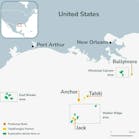Third quarter earnings down on lower commodity prices
A group of 54 US-based oil and gas producers and refiners recorded a total net income of $12.93 billion in this year’s third quarter, compared to earnings of $22.25 billion in the previous year’s third quarter. Total revenues were $238.69 billion for the quarter, compared to $261.13 billion a year ago.
Brent crude oil prices averaged $61.93/bbl in this year’s third quarter and ended October near $59/bbl. This compared with $75.22/bbl in third-quarter 2018 and $68.92/bbl in the second quarter of this year. West Texas Intermediate (WTI) averaged $56.37/bbl in this year’s third quarter and ended October close to $54/bbl. This compared with $69.76/bbl in third-quarter 2018 and $59.78/bbl in this year’s second quarter.he spread between Brent and WTI narrowed during this year’s third quarter due to pipeline debottlenecking projects enabling inland crude to gain access to refineries and export terminals on the US Gulf Coast.
For the quarter, US crude oil production averaged 12.23 million b/d compared to 11.24 million b/d in third-quarter 2018, according to the US Energy Information Administration. US natural gas plant liquids (NGPL) production averaged 4.8 million b/d during the quarter, compared to 4.54 million b/d a year ago.
According to Baker Hughes, the number of active oil rigs in the US slipped from around 790 at the end of June to around 690 at the end of September.
US marketed gas production for the quarter ramped up to 99 bcfd from 91.5 bcfd a year earlier, according to EIA. Increased gas production depressed gas prices. Henry Hub natural gas spot prices averaged $2.38/MMbtu in this year’s third quarter, compared to $2.93/MMbtu a year earlier.
US refinery inputs were 17.43 million b/d during the third quarter, compared with 17.68 million b/d over the same period a year ago. The refinery utilization rate was 93% compared to 95% a year earlier.
Narrower Brent and WTI spread contributed to lower refining margins. According to Muse, Stancil & Co, refining cash margins in this year’s third quarter averaged $16.29/bbl for Middle-West refiners, $14.17/bbl for West Coast refiners, $7.04/bbl for Gulf Coast refiners, and $4.38/bbl for East Coast refiners. In the same quarter of the prior year, these refining margins were $13.61/bbl, $28.59/bbl, $9.09/bbl, and $3.92/bbl, respectively.
A sample of 12 companies based in Canada, including oil and gas producers and pipeline operators, reported total earnings of $4.93 billion (Can.) in this year’s third quarter. In third-quarter 2018, this group’s total earnings were $5.53 billion.
Prices for Western Canadian Select (WCS) at Hardisty decreased to $44.20/bbl in this year’s third quarter vs. $47.35/bbl in the same quarter last year, which was less than the decrease in WTI as a result of narrowing heavy crude differentials in part due to mandatory production curtailments in Alberta.
US oil and gas producers
ExxonMobil Corp. posted a net income of $3.17 billion for this year’s third quarter as compared to net earnings of $6.24 billion for third-quarter 2018. Earnings included a favorable tax-related identified item of about $300 million. Capital and exploration expenditures were $7.7 billion, including key investments in the Permian basin.
ExxonMobil’s oil-equivalent production rose 3% from third-quarter 2018 to 3.9 million b/d, driven by Permian basin growth. Permian unconventional production was up 7% from this year’s second quarter and more than 70% from the third quarter of last year. Natural gas volumes increased 1%.
In the downstream, industry fuels margins improved from the second quarter on stronger distillate margins in Europe and Asia Pacific. Meantime, following completion of significant refinery turnaround activity during the second quarter, scheduled maintenance activity was lower in the third quarter.
Chevron Corp. announced a net profit of $2.58 billion for this year’s third quarter, down from a net income of $4.05 billion for third-quarter 2018. Included in the current quarter was a tax charge of $430 million related to a cash repatriation.
Chevron’s worldwide net oil-equivalent production was 3.03 million b/d in this year’s third quarter, an increase of 3% from 2.96 million b/d from third-quarter 2018. Third quarter unconventional net oil-equivalent production in the Permian basin was 455,000 b/d, representing growth of 35% compared to third-quarter 2018. However, lower crude oil and natural gas prices more than offset the increase in production.
US downstream operations earned $389 million in this year’s third quarter, down from $748 million a year earlier due to higher operating expenses, primarily turnaround and maintenance costs and lower margins on refined product sales. Refinery crude oil input in this year’s third quarter increased 8% to 992,000 b/d from the year-ago period, primarily due to the acquisition of the Pasadena refinery in Texas.
International downstream operations earned $439 million in the quarter, compared with $625 million in third-quarter 2018, largely due to the absence of 2018 gains from the southern Africa asset sale.
ConocoPhillips recorded a net income of $3 billion for this year’s third quarter, up from net earnings of $1.86 billion in third-quarter 2018. Earnings increased primarily due to the gain from the UK divestiture, partially offset by lower realized prices. Excluding special items, adjusted earnings were lower compared with third-quarter 2018 due to lower realized prices and higher exploration expenses from increased dry hole costs, partially offset by higher volumes.
ConocoPhillips’ production, excluding Libya, for the third quarter was 1.3 million boe/d, a 98,000 boe/d increase over the same period a year ago. Adjusting for closed dispositions and acquisitions, underlying production increased 83,000 boe/d primarily due to production growth from the Eagle Ford, Bakken, and the Permian basin, development programs and major projects in Alaska, Europe, and Asia Pacific. This growth more than offset normal field decline.
Devon Energy Corp. announced a net income of $109 million for this year’s third quarter, down from net earnings of $2.54 billion in third-quarter 2018. The decrease was mainly due to the absence of net earnings from discontinued operations.
EOG Resources Inc. posted a net income of $615.1 million for this year’s third quarter compared with a net income of $1.2 billion in the quarter a year earlier. Total crude oil volumes of 464,100 b/d in this year’s third quarter increased 12% compared to the same prior year period.
Natural gas liquids and natural gas volumes each grew 11%. EOG incurred total expenditures of $1.6 billion in the third quarter.
EOG’s per‐unit transportation costs declined 9% compared to the same prior‐year period, depreciation, depletion and amortization expenses fell 7% year‐over‐year, and lease and well expenses declined 3% year‐over‐year.
Marathon Oil Corp. reported net earnings of $165 million for this year’s third quarter as compared to a net income of $254 million for third-quarter 2018.
The company’s US production averaged 339,000 boe/d for this year’s third quarter, including 201,000 net b/d of oil. Oil production was above the top end of the third quarter guidance range and up 17% from the year-ago quarter on a divestiture-adjusted basis. US unit production costs were $4.75/boe, down 23% from the year-ago quarter, the lowest quarterly average unit production costs since 2011. International production averaged 87,000 net boe/d for this year’s third quarter. Unit production costs averaged $1.98/boe.
Marathon Oil closed on the sale of its UK business July 1, removing $966 million of asset retirement obligations. Coupled with the second quarter close on the sale of the company’s last block in Kurdistan, Marathon Oil’s international portfolio has been simplified to only include the free cash flow generative integrated business in Equatorial Guinea.
Occidental Petroleum Corp. posted a third quarter a loss of $912 million compared with a net income of $1.87 billion in third-quarter 2018. Third quarter pre-tax items affecting comparability mainly include Anadarko merger-related transaction costs and debt financing fees of $969 million, oil and gas impairment charges of $325 million, and a gain on sale of $111 million related to Occidental’s sale of its interests in Plains. Excluding impairment charges and the mark-to-market gain, the decrease in third quarter income reflects lower realized crude oil prices.
US refiners
Marathon Petroleum Corp. announced third-quarter 2019 net earnings of $1.1 billion compared with a net income of $737 million for the prior year’s quarter. Adjusted net income was $1.1 billion compared to $774 million for the third quarter of 2018.
Refining and Marketing (R&M) segment income was $883 million in this year’s third quarter compared with $666 million in the same quarter of 2018. The year-over-year increase was primarily due to higher throughputs as a result of the Andeavor combination. R&M margin was $14.66/bbl for the quarter.
Phillips 66 reported a net income of $712 million for this year’s third quarter, down from a net income of $1.49 billion in third-quarter 2018. Excluding special items of $690 million in the third quarter, primarily impairments related to the company’s investment in DCP Midstream LLC, adjusted earnings were $1.4 billion compared with second-quarter adjusted earnings of $1.4 billion.
Refining adjusted pre-tax income was $839 million in this year’s third quarter compared with $983 million in the year’s second quarter. The decrease is mainly due to higher turnaround costs, as well as lower realized margins, primarily reflecting weaker gasoline crack spreads in the Central Corridor.
Valero Energy Corp. announced a net income of $609 million for this year’s third quarter, down from net earnings of $856 million in third-quarter 2018. The refining segment reported $1.1 billion of operating income for the third quarter of 2019 compared to $1.4 billion for the third quarter of 2018. The decrease was primarily driven by narrower crude oil discounts to Brent crude oil.
HollyFrontier Corp. posted a net income of $261.8 million for this year’s third quarter, down from a net income of $342.5 million in third-quarter 2018. The third quarter results reflect special items that collectively decreased net income by a total of $16.2 million. Excluding these items, net income for the current quarter was $278 million compared to $350.7 million for the third quarter of 2018.
The R&M segment reported adjusted EBITDA of $424.6 million compared to $507.2 million for the third quarter of 2018. This decrease was primarily driven by lower product margins and weaker laid-in crude advantage.
Canadian firms
All financial figures are presented in Canadian dollars unless noted otherwise.
Cenovus Energy Inc. recorded a net income of $187 million for the year’s third quarter, up from a net loss of $241 million in third-quarter 2018. While Cenovus achieved stronger realized pricing in the third quarter of this year, upstream revenue was impacted by higher royalties and lower volumes. Third-quarter revenue from refining and marketing decreased from the same period a year earlier due to lower refined product pricing.
Imperial Oil Ltd. posted a net profit of $424 million for the third quarter of 2019, down from a net income of $749 million in third-quarter 2018. Overall upstream gross oil-equivalent production averaged 407,000 b/d, up from 393,000 bo/d in the third quarter of 2018. Gross production at Kearl averaged 224,000 b/d in the third quarter, with production for the first 9 months of the year averaging 204,000 b/d.
Suncor Energy Inc. posted a net income of $1.03 billion for this year’s third quarter, down from net earnings of $1.81 billion in third-quarter 2018. Suncor’s third quarter 2019 operating earnings were $1.12 billion, compared to $1.56 billion in the prior year quarter, with the decrease primarily related to a weaker business environment resulting in a decrease in crude oil price realizations and lower refining margins. Partially offsetting these were higher crude oil production, increased refinery crude throughput, and the impact of a weaker Canadian dollar on US dollar denominated sales.

Conglin Xu | Managing Editor-Economics
Conglin Xu, Managing Editor-Economics, covers worldwide oil and gas market developments and macroeconomic factors, conducts analytical economic and financial research, generates estimates and forecasts, and compiles production and reserves statistics for Oil & Gas Journal. She joined OGJ in 2012 as Senior Economics Editor.
Xu holds a PhD in International Economics from the University of California at Santa Cruz. She was a Short-term Consultant at the World Bank and Summer Intern at the International Monetary Fund.

Laura Bell-Hammer | Statistics Editor
Laura Bell-Hammer has been the Statistics Editor for the Oil & Gas Journal since 1994. She was the Survey Editor for two years prior to her current position with OGJ. While working with OGJ, she also was a contributing editor for Oil & Gas Financial Journal. Before joining OGJ, she worked for Vintage Petroleum in Tulsa, gaining her oil and gas industry knowledge.


